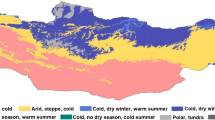Abstract
Temporal distribution of landslides can be verified by means of climatic anomalies linked to the ENSO phenomenon. An increasing number of landslides triggered by rainfall have been recorded during warm episodes (El Niño) in the Cordillera Frontal, and a decreasing number during cold episodes (La Niña), concluding that this geological province is mainly influenced by the Pacific Anticyclone. However, slope instability in the Precordillera, located east of the Cordillera Frontal, seems to be mainly influenced by the Atlantic Anticyclone. Analysis of variance shows that there is no significant difference between landslide records and cold-warm episodes, and a higher number of landslides were recorded in years linked to wet periods than during dry periods. Furthermore, the precipitation threshold value associated with landslide occurrence and antecedent precipitation are analysed.






Similar content being viewed by others
References
Agosta EA, Compagnucci RH, Vargas WM (1999) Cambios en el régimen interanual de la precipitación estival en la región Centro-Argentina. Meteorol 24(1/2):63–84
Bandhari RK, Senanayake KS, Tayalan N (1991) Pitfalls in predicition of landslides through rainfall data. In: Bell (ed) Landslides. VI International Conference on Landslides, Balkema 2:887–890
Cannon SH, Ellen SD (1985) Rainfall conditions for abundant debris avalanches: California geology, vol 38, San Francisco, CA, pp 267–272
Cayan DR, Webb RH (1992) El Niño/Southern oscillation and streamflow in the Western United States. In: Diaz and Markgraf (eds) El Niño. Historical and paleoclimatic aspects of the Southern Oscillation. Cambridge University Press, pp 29–68
Compagnucci RH, Vargas WM (1983) Spectral analysis of summer precipitation series. Preprints, II International meeting on Statistical Climatology, Lisbon, Portugal, Inst Nac Meteorol geogr (eds), pp 11.7.1–11.7.8
Compagnucci RH, Vargas WM (1998) Inter-annual variability of Cuyo rivers streamflow in the Argentinean Andean mountains and ENSO events. Int JClimatol 18:1593–1609
Compagnucci RH, Agosta EA, Vargas WM (2002) Climatic change and quasi-oscillations in central-west Argentina summer precipitation: main features and coherent behaviour with southern African region. Clim Dynam 18:421–435
Corominas J, Moya J (1996) La datación de deslizamientos: implicaciones dinámicas y climáticas. Actas VI Congreso Nacional y Conferencia Internacional de Geología Ambiental y Ordenación del Territorio, Granada, vol. 1, pp 337–356
Díaz HF, Kiladis GN (1992) Atmosferic teleconnections associated with the extremes phases of Southern Oscillation. In: Diaz y Markgraf (eds) El Niño historical and paleoclimatic aspects of the Southern Oscillation. Cambridge University Press, pp 7–28
Ellen SD, Wieczorek GF (eds) (1988) Landslides, floods, and marine effects of the storm of January 3–5, 1982, in the San Francisco Bay region, California: U.S. Geological Survey Professional Paper 1434
Glantz M (1995) Currents of change: El Niño’s impact on climate and society. Cambridge University Press, 194 p
Godt JW, Highland LM, Savage WZ (1997) El Niño and the National Landslide Hazard Outlook for 1997–1998. U.S. Geological Survey, fact sheet 180–97
Leiva JC, Cabrera GA (1996) Glacier mass balance analysis and reconstruction in the Cajón del Rubio, Mendoza, Argentina. Zeitschrift für Gletscherkunde und Glazialgeologie. Band 32S:101–107
Moreiras SM (2003) Remoción en masa en un sector del valle del Río Mendoza. Mendoza, Argentina. Untar Ciencia, Revista Científica de la Universidad Nacional de La Rioja. Año 4-N° 1, vol. 2, 2003:2–10
Moreiras SM (2004a) Landslide incidence zonation in the Rio Mendoza valley, Mendoza province, Argentina. Earth Surface Processes and Landforms 29:255–266
Moreiras SM (2004b) Zonificación de peligrosidad y riesgo de procesos de remoción en masa en el valle del Río Mendoza. PhD thesis. Facultad de Ciencias Exactas, Físicas y Naturales. Universidad Nacional de San Juan (unpublished)
Ngecu WM, Mathu EM (1999) The El Niño Triggered landslides and their socio-economic impacts on Kenya Episodes, vol 22-no4
Prieto MR, Herrera RG, Dussel P (1995) Evidencias históricas de fluctuaciones climáticas en la Cordillera de Los Andes a partir del estudio diacrónico del caudal del Río Mendoza (siglos VVII al XX). Climatología y contaminación del aire. Universidad Nacional de Cuyo, 13–27 August, 1995, Mendoza
Reynolds R, Dettinger M, Cayan D, Stephens D, Highland L, Wilson R (1997) Effects of El Niño on streamflow, lake level, and landslide potential. U.S. Geological Survey Open file report
Walker GT (1923) Correlation in seasonal variations of weather. Part VIII: A preliminary study of world weather. Mem Indian Meteorol Deptt 24:75–131
Waylen P, Caviedes C (1990) Annual and seasonal fluctuations of precipitation and streamflow in the Aconcagua River basin, Chile. J Hidrol 120:79–102
Wieczorek GF (1996) Landslide triggering mechanisms. In: Turner AK, Schuster RL (eds) Landslides: investigation and mitigation: Special Report 247; Transportation Research Board, National Research Council, pp 76–90
Wieczorek GF, Lips EW, Ellen SD (1989) Debris flows and hyperconcentrated floods along the Wasatch Front, Utah, 1983 and 1984. Bull Assoc Eng Geol 26:191–208
Acknowledgements
I especially want to thank Ricardo Villalba for his continuous assistance and critical review of the original paper. I am grateful to Robert Schuster for useful comments and to N. Horak for checking the English version. This research was funded by a research grant from the CONICET (National Council of Scientific and Technological Research) and a grant from the Antorchas Foundation (Res. 48/2003)
Author information
Authors and Affiliations
Corresponding author
Rights and permissions
About this article
Cite this article
Moreiras, S.M. Climatic effect of ENSO associated with landslide occurrence in the Central Andes, Mendoza Province, Argentina. Landslides 2, 53–59 (2005). https://doi.org/10.1007/s10346-005-0046-4
Received:
Accepted:
Published:
Issue Date:
DOI: https://doi.org/10.1007/s10346-005-0046-4




